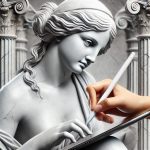Digital art has exploded in popularity over the past decade, captivating audiences with its vibrant colors, intricate details, and innovative techniques. However, despite its growing influence, digital artists often face significant bias within traditional art circles. This article delves into the roots of this bias, explores the experiences of digital artists, and considers how perceptions are changing.
The Rise of Digital Art
Digital art, as a medium, has a relatively short but dynamic history. It began in the 1960s with experiments in computer graphics but truly started to gain traction in the 1980s with the advent of personal computers and graphic design software. Artists like Harold Cohen, who created the computer program AARON to generate art, were pioneers. These early days set the stage for what would become a thriving field of artistic expression.
In recent years, digital art has become more mainstream, thanks in part to social media platforms and online galleries. Websites like DeviantArt, ArtStation, and Instagram have allowed digital artists to showcase their work to a global audience. According to a 2020 report by the market research firm Statista, the global digital art market was valued at $13.8 billion and is expected to grow substantially.
Key movements in digital art, such as pixel art, 3D modeling, and digital painting, have pushed the boundaries of creativity. Artists like Beeple, who sold a digital artwork for $69 million at Christie’s in 2021, and Banksy, who has embraced digital mediums in his latest works, demonstrate the potential and appeal of digital art. These developments indicate a shift towards wider acceptance and recognition of digital art as a legitimate form of artistic expression.
Despite these advancements, digital artists often encounter skepticism and bias from traditional art circles. This prejudice stems from a deep-rooted belief in the superiority of traditional art forms, which have been established and revered for centuries.
Traditional Art Circles: An Overview
Traditional art circles encompass galleries, museums, critics, and collectors who have long upheld the standards and practices of classical art forms. These institutions play a critical role in determining what is considered “high art” and often set the trends that influence the broader art market.
Art galleries and museums have historically been the gatekeepers of artistic recognition and success. They curate exhibitions, host events, and promote artists whose work aligns with their values and aesthetics. This system has worked well for centuries, ensuring that certain styles and techniques are preserved and celebrated.
The cultural significance of traditional art cannot be overstated. Classical paintings, sculptures, and other forms of traditional art are deeply embedded in the history and identity of many societies. Masterpieces by artists like Leonardo da Vinci, Michelangelo, and Vincent van Gogh are not just artworks but symbols of cultural heritage and human achievement.
In traditional art circles, prestige and recognition are often tied to an artist’s mastery of classical techniques and their ability to contribute to the established canon of art history. This emphasis on tradition can create a barrier for digital artists, whose work may not conform to these established norms.
However, this doesn’t mean that traditional art circles are completely closed off to new forms. Some contemporary galleries and museums have started to include digital art in their exhibitions, acknowledging its growing influence and importance. Yet, the overall bias remains a significant hurdle for many digital artists seeking validation and success within these traditional frameworks.
Sources of Bias Against Digital Artists
One of the primary sources of bias against digital artists is the perception of effort and skill. Traditional art circles often view digital art as “easier” or less labor-intensive than traditional methods. This misconception stems from the belief that digital tools simplify the artistic process to the point where anyone can produce art without much effort or skill. However, creating high-quality digital art requires a deep understanding of software, technical skills, and a strong artistic vision.
Authenticity and originality are also common points of contention. Critics argue that digital art lacks the “authenticity” of traditional mediums, where each piece is a unique, tangible object. Digital art, being reproducible and often intangible, challenges the traditional notion of what makes art valuable and original. This debate is similar to the discussions that arose with the advent of photography and printmaking, where the ability to reproduce an image was initially seen as diminishing its value.
The market value of digital art compared to traditional art is another significant factor. Traditional artworks, especially those by well-known artists, often fetch high prices at auctions and are considered valuable investments. Digital art, on the other hand, has struggled to achieve the same level of market acceptance and financial worth. The introduction of NFTs (non-fungible tokens) has started to change this, but there is still a long way to go before digital art is valued on par with traditional forms.
These biases are deeply ingrained and perpetuated by a lack of understanding and appreciation for the unique challenges and possibilities offered by digital art. As more artists and collectors begin to recognize the value and potential of digital art, these perceptions may start to shift.
Case Studies: Personal Stories from Digital Artists
To understand the real impact of bias against digital artists, it’s important to listen to their stories. Take the case of Anne Spalter, a pioneering digital artist and educator. She has often spoken about the challenges she faced in gaining acceptance for her work within traditional art circles. Despite her significant contributions to digital art, including founding digital fine arts programs at prestigious institutions, Spalter has encountered skepticism and resistance from traditional art communities.
Another example is the experience of artist Mike Winkelmann, better known as Beeple. Despite his recent success, Beeple spent years producing digital art daily without much recognition from traditional art institutions. His story underscores the persistence and dedication required to break through the biases that often marginalize digital artists.
Digital artist Krista Kim, known for her “Techism” movement, has also highlighted the struggle for acceptance. Kim’s work blends digital technology with artistic expression to create immersive experiences. However, she has noted that traditional art critics and galleries often overlook the innovation and creativity involved in digital art, favoring more conventional forms instead.
These stories are not just about personal struggles but also about the broader challenges faced by digital artists as they seek validation and recognition. The bias against digital art is not merely a theoretical issue but a real barrier that affects careers, opportunities, and the evolution of the art world.
The Role of Technology
Technology plays a central role in digital art, shaping both its creation and reception. Digital artists use a variety of tools and techniques, from graphic tablets and styluses to advanced software like Adobe Photoshop, Illustrator, and Blender. These tools offer capabilities that traditional mediums cannot match, such as the ability to undo mistakes, work in layers, and experiment with different effects effortlessly.
Innovation and creativity in digital art are driven by technology. Artists can explore new styles, blend different techniques, and create works that would be impossible in traditional media. For example, 3D modeling and animation allow artists to bring their creations to life in ways that traditional sculpture cannot. Virtual reality (VR) and augmented reality (AR) open up new dimensions for interactive and immersive art experiences.
Education and accessibility are also significant aspects of digital art. Many digital art tools are relatively affordable and accessible, making it easier for aspiring artists to learn and create without the high costs associated with traditional art supplies. Online tutorials, courses, and communities provide valuable resources and support, helping artists develop their skills and connect with others.
Despite these advantages, the reliance on technology can also be a source of bias. Traditional art circles may view digital art as less “authentic” because it involves computers and software. However, this perspective overlooks the fact that technology is simply another tool in the artist’s toolkit, much like a paintbrush or chisel. The creativity and skill required to produce compelling digital art are no less than those needed for traditional art forms.
Changing Perceptions
Fortunately, perceptions of digital art are gradually changing. One significant driver of this shift is the younger generation, who have grown up with digital technology and are more open to its artistic possibilities. Millennials and Gen Z are more likely to appreciate and value digital art, seeing it as a natural extension of the creative landscape.
Social media platforms like Instagram, TikTok, and Twitter have played a crucial role in promoting digital art. These platforms allow artists to reach large audiences, share their creative process, and receive instant feedback. The viral nature of social media can catapult digital artists to fame and recognition, bypassing traditional gatekeepers.
Success stories of digital artists breaking through traditional barriers are becoming more common. Beeple’s record-breaking NFT sale is a prime example, but there are many other artists who have gained recognition and success through digital mediums. Artists like Trevor Jones and Pak have also made significant strides in the digital art world, challenging the traditional notions of art and value.
Exhibitions and events featuring digital art are also on the rise. Major galleries and museums are beginning to recognize the importance of digital art and are including it in their collections and exhibitions. This increased visibility helps to legitimize digital art and reduce the bias against it.
Bridging the Gap: Integrating Digital and Traditional Art
Integrating digital and traditional art can create exciting possibilities and help bridge the gap between the two worlds. Collaborations between digital and traditional artists can result in innovative and hybrid works that combine the best of both mediums. For example, traditional painters might use digital tools to enhance their work or explore new techniques.
Exhibitions and events that feature both digital and traditional art can showcase the diversity and richness of contemporary art. By presenting these forms side by side, galleries and museums can encourage audiences to appreciate the unique qualities of each and see them as complementary rather than competing.
The future of art lies in the integration of digital and traditional forms. As technology continues to evolve, the boundaries between different types of art will become increasingly blurred. Artists will have more tools and opportunities to express their creativity, and audiences will have more ways to experience and engage with art.
The art world is slowly but surely moving towards a more inclusive and integrated approach that values all forms of artistic expression. This shift is essential for the continued growth and evolution of art in the digital age.
Conclusion
The bias against digital artists in traditional art circles is a complex issue rooted in historical, cultural, and economic factors. However, as digital art continues to grow in popularity and influence, these biases are beginning to shift. By understanding the sources of bias, listening to the experiences of digital artists, and recognizing the role of technology in shaping art, we can work towards a more inclusive and equitable art world.
As Anne Spalter aptly puts it, “Art has always been about pushing boundaries and exploring new frontiers. Digital art is just another step in that journey.” This quote underscores the importance of embracing all forms of art and recognizing the value that digital artists bring to the creative landscape. By doing so, we can ensure that art continues to evolve and inspire future generations.




